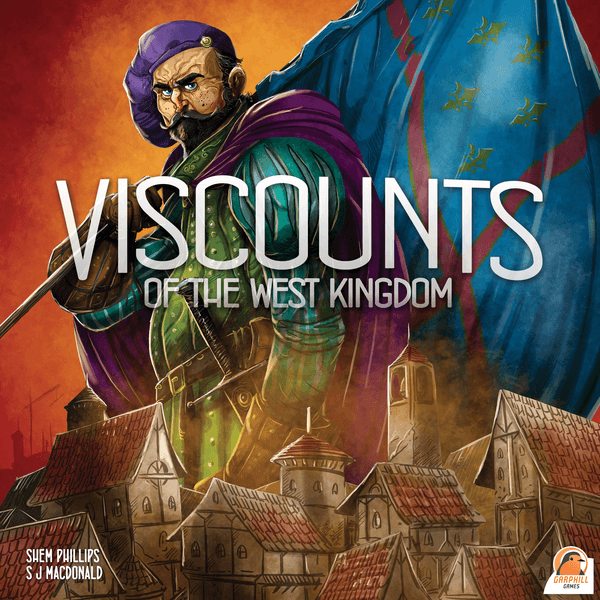The West Kingdom Trilogy – First Impressions (Kinda)
With the release of Viscounts, Shem Phillips and S J Macdonald have finally finished the West Kingdom trilogy. As the North Sea trilogy before it, it’s a worker-placement series that features innovative mechanics that have distinguished Shem Phillips in the genre and continued to showcase the beautiful artwork from The Mico.
So, even though I’ve played each of these games more than once, I decided to feature the whole trilogy in this week’s first impression article because, if we’ve learned anything from our most recent Played It Once podcast episode with special guest Jeremy Howard, it’s that you can break the rules every now and then.
If you’re worried that all three games are just an iteration of the same idea, then don’t be. The overall goal and mechanics of each game are quite different, but the iconography, artwork, and worker-placement design are shared across the trilogy.
For those that haven’t played the games at all, I’ll try to give you a good sense of what to expect and what’s good about it. For gamers intimately familiar with the games of the West Kingdom trilogy, let me know if I forget any valuable tidbits!
What It Does
Architects of the West Kingdom starts off the story of the Carolingian Empire. Players compete as architects who are working to build landmarks and to help construct the cathedral which is the dominant structure in the empire. It involves collecting resources that act as the raw materials for building. It features apprentices that grant each architect bonuses and additional actions. And it requires a careful eye on the workers of every player. A virtue system tracks the noble or criminal enterprises of each architect and the game ends with a tally of victory points for which the highest-scoring player wins.
I like how the interplay of worker-placement, variable player powers (with the apprentices), and resource management. You can’t really go for everything. Someone who wades far into the landmark building may not be able to contribute much to the Cathedral, for example.
Paladins of the West Kingdom takes place about 50 years after Architects, and it involves West Francia, a city that is poorly fortified, under siege from outsiders, and in need of soldiers and workers who can transform the land. Paladins are recruited to solve the many problems that the city faces: 1) fighting off the Saracens, Vikings, and Byzantines; 2) spreading faith and piety across the land with conversions, absolutions, and missionaries; 3) fortifying and garrisoning the city to help defend against outsiders and increase the strength of West Francia.
What’s unique about Paladins is the central board being reserved for player benefits rather than worker-placement. A player’s workers are put on their own personal boards, which doesn’t prevent anyone from being blocked by another player. It’s up to each individual to discover the strategy that they want to implement. Just as in Architects, you can’t do everything. You have to decide what path you want to take and which city improvements to prioritize.
Viscounts of the West Kingdom occurs almost 100 years later, with the gradual decline of the King’s reign in the empire. Whether the people become prosperous or destitute is left up to the viscounts, who act as servants of the king. These stewards of royalty must balance their actions wisely. Construct buildings, transcribe manuscripts, and engage in a tussle for influence and control in the castle itself while you move throughout the kingdom to demonstrate the King’s will and intent.
Townsfolk aid the viscounts in their mission, but it will involve traveling to the right places in order to win the day. Players need to increase their influence but make sure that they are ready for the kingdom ascending into riches or falling to despair. Either outcome could be beneficial depending on the deeds and the debts of the players.
How It Does It
The West Kingdom trilogy is definitely more “crunchy” than other Shem Phillips designs like Raiders of the North Sea. There is just more going on. And these three games are more involved than classic or introductory worker-placement games like Lords of Waterdeep and similarly-weighted classics in the genre.
But all of that is pretty approachable given the near-universal iconography between the three games. Once you’ve played one, it’s even easier to play the next and you can likely intuit what a card or action does just by understanding how other games in the trilogy work. Recruiting a townsfolk card in any of the three games. The immediate benefits, ongoing actions, and endgame bonuses appear in similar areas whether you’re playing Architects, Paladins, or Viscounts. Same for a lot of the other mechanics in the game.
Each entry in the trilogy handles worker-placement a little differently, but they are all united in a more catholic West Kingdom aesthetic that makes each game quite accessible to players who might otherwise be intimidated by its more complex ideas.
All three of the games focus on the idea of placing workers in the right spots with the right resources while also recruiting townsfolk in savvy and beneficial ways to increase the value of every move you make. They accomplish this in differing ways, but the guiding principle is the same: find a chain of cascading resources and rewards and aim it in the right direction for whatever building or plan of action you’ve devised. Do it properly and you can continue the waterfall of advantageous play rather than stumbling around from action to action.
To be clear, I still think these games are fun if you stumble around, but more experienced or discerning tabletop gamers will be able to enjoy a high ceiling of strategic play.
Why You Might Like It
If you are a fan of worker-placement games, then the West Kingdom trilogy is a great experience. The Mico’s art pulls you into the world and the refreshingly different design from Shem Phillips and S J Macdonald keeps you anchored into the game. At the endgame scoring, you’ll be left wondering how you could have capitalized better on the turns you had and what results would have stemmed from using a different strategy.
If one game doesn’t satisfy you, then one of the others still might. Each one can make a good argument for one of your go-to worker-placement games.
Why You Might Not
You still might like the West Kingdom trilogy even if worker-placement isn’t your go-to for board games. But that’s the main mechanic driving each game, so it’s going to be a tough pill to swallow if you prefer other mechanics.
Also, the theme and physical interaction between players aren’t as immersive as other games. Viscounts is the only game in which you control a meeple moving around the board. And all three of them mainly feature players moving workers to different spots and receiving resources. If you’re looking for a story that will grip you and a world to get lost in, these are not the games for you.
Final Thoughts
Some people might end up preferring just one of the games over the others. And for the slim board game collections out there, it’s totally reasonable to keep one and get rid of the other two—especially since there are upcoming expansions that will make each individual game more robust and interesting.
However, I like all three of the games. They each have different types of player interaction and I thoroughly enjoy worker-placement games. I’m not good at them. My wife beats me all the time. But I like them. And it’s always a treat to get The Mico’s work on the table. His illustrations are so colorful and alive.
Architects boasts the most player interaction of the three, with players investing workers on certain locations that become more valuable the more populous the spot. It will encourage players to watch what the others are doing and possibly cull a location and dump everyone in the prison. It’s fun but not antagonistic and it’s an exciting balance of figuring out when and what to build. Virtue isn’t always the right answer to success here.
Paladins is the crunchiest of the three, in my opinion, and it’s got some of the most satisfying payoff when you figure out the right combination of actions. The six main ones require one attribute to activate and then they reward another attribute, so it’s fun to discover which actions you want to spiral into others. It’s got the highest ceiling of strategic play, but it’s still accessible, especially if you’re familiar with the other games in the trilogy.
Viscounts has the best table presence, given the three-dimensional castle in the middle where players fight in a king of the hill conflict for influence in the kingdom. It’s also the most physical, as players control their viscount meeples and roam the board in search of the best actions. It’s the middleweight contender for complexity and it rounds out the trilogy nicely.
Whichever one you pick up, I think you’ll like it. It will just be a matter of taste and preference as to which one(s) you keep, if any. For me, though, I'm excited awaiting any and all news about the expansions that will make these games more beautiful to behold.
And if you want to know more, check out Architects, Paladins, and Viscounts on BGG for all the extra tabletop info you crave.
I want to hear what you think, though! Do you like the West Kingdom games? Give a shoutout in the comments for your favorite of the three. Are you interested in any of the upcoming expansions?
If you don’t like the West Kingdom trilogy, what’s a worker-placement game that you do like?













